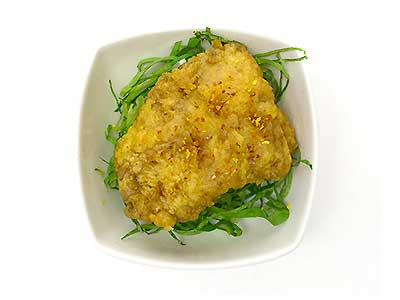May 5, 2014
Amuse-Bouche

poulet « nanban »
(sweet and sour chicken)
Most often, marinating doesn’t live up to it’s reputation. In the 1960s it was touted as the savior of tough meat. It didn’t work then, and it doesn’t work now.
Most meat marinade recipes I encounter have soy sauce in them. At slightly greater than fifteen percent salinity, I wouldn’t be surprised if the soy sauce had some brining effect. It certainly does color the meat on the surface and a slight ways inward, but I’ve never noticed any measurable effect from the solids present in most marinades. Sure, the sugar will make the outside surface sweeter, but the sweetness is very shallow.
I have a few French recipes that describe a post-cooking marinating process. The protein is cooked with a coating and then soaked in a flavoring solution. The coating absorbs the flavor. It’s really just a sauce that is absorbed into the coating. If you’ve ever sprinkled malt vinegar on your order of fish and chips, it’s very similar. I like the concept.
Chicken nanban was apparently originally conceived at a family-style restaurant called Ogura located in the southern Japanese city of Miyazaki. I was introduced to it on the Cooking with Dog website. I don’t remember eating it in Japan on one of my many trips there. The closest I got to Miyazaki was Kagoshima, a two-hour drive from it.
Chicken nanban is generally prepared from a chicken breast cut and or pounded into a cutlet shape. It is breaded with flour and beaten egg, and is then fried in oil. When cooked, it is immediately placed in a sweet and sour sauce that also has a bit of spice added. In Japan, the chicken is served with a big dollop of Japanese-style tartar sauce.
For use as an amuse-bouche, I decided to shrink the cutlet into a single bite, use chicken thighs instead of the usual chicken breast, and eighty-six the tartar sauce.
1 small
boneless, skinless chicken thigh cut into 2.5-cm (1-in) squares
splash
sake
fine salt
all-purpose flour
1
egg, well beaten
sprinkling
ichimi togarashi
nanban sauce
1-1⁄2 T
mirin
1 T
soy sauce
1-1⁄2 T
rice vinegar
1. Sprinkle a little sake and salt over the chicken squares, massage a bit, and set aside for an hour or so.
2. Combine the sauce ingredients together in a bowl large enough to hold the chicken pieces when they are cooked.
3. Heat oil for deep-frying to about 180 °C (355 °F).
4. Dust the chicken pieces with flour. Dip the pieces into the beaten egg. Fry the battered chicken pieces until the coating is crisp and golden. Drain well.
5. Dip the chicken pieces into the sauce for a minute or so. Drain.
6. Serve the cooked chicken pieces with a sprinkling of ichimi togarashi.
Note: Serve on some finely shredded lettuce.
Yield: 6 servings.
© 2014 Peter Hertzmann. All rights reserved.
